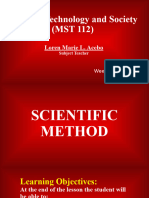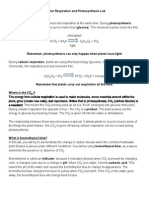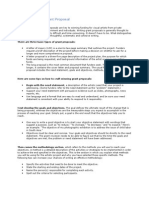Ds24-Unit 1 Final Review
Ds24-Unit 1 Final Review
Uploaded by
api-110789702Copyright:
Available Formats
Ds24-Unit 1 Final Review
Ds24-Unit 1 Final Review
Uploaded by
api-110789702Original Title
Copyright
Available Formats
Share this document
Did you find this document useful?
Is this content inappropriate?
Copyright:
Available Formats
Ds24-Unit 1 Final Review
Ds24-Unit 1 Final Review
Uploaded by
api-110789702Copyright:
Available Formats
UNIT 1: The Scientific Method DAYSHEET 24: Unit 1 Final Review
Biology I
Name :________________________________________________ Date:____________________________
Bellringer
Directions: Complete each section of the Unit 1 practice assessment below. Use this tool to help you determine what you still need to study this evening to prepare for the real test administered during our next class.
Topic 1: Why Study Biology (Daysheet 1) 1. Why are you enrolled in Biology? ________________________________________________________ ____________________________________________________________________________________ ____________________________________________________________________________________ 2. How does your success in this Biology class impact the rest of your high school career? ____________________________________________________________________________________ ____________________________________________________________________________________ 3. What does Biology mean? ______________________________________________________________ 4. You should do well in this course and your other high school courses to earn a __________________________________. 5. If you earn a high school diploma you can get into a good _______________________________. 6. When you get into a good college you can earn a ______________________________________. 7. When you earn a college degree you can get a _________________________________________. 8. If is important to get a good job so you dont __________________________________________. Topic 2: What is Science? What is NOT Science? (Daysheet 2) Classify each of the following statements as what science is (S) or what science is NOT (NS). 1. _____ Testable 2. _____ Repeatable 3. _____ Measurable 4. _____ Peer- Reviewed 5. _____ Certain 6. _____ Absolute 7. _____ Changeable 8. _____ Rigid 9. _____ Observable 15. _____ Based on belief 10. _____ Modifiable 11. _____ Based on Experimentation 12. _____ Can solve all problems 13. _____ Based on faith 14. _____ Limited to the Natural World
Topic 3: How do Scientists Study the Natural World? (Daysheet 3-5) Classify the following as Observations (O) or Inferences (I). 1. _____ The fence is four meters high. 2. _____ The dog has long ears. 3. _____ The grass was wet because the sprinkler was on. 4. _____ The fire alarm went off because Ms. Cook was probably cooking again. 5. _____ Ms. Cook is a teacher because she likes working with children. Classify the following observations as either Quantitative (QN) or Qualitative (QL). 6. _____ The dog weighed fifty-seven pounds when he was last weighed. 7. _____ Ms. Cook is wearing a red laboratory coat. 8. _____ There was one book on each desk. 9. _____ Our biology class has completed 5 laboratories so far this year. 10. _____ Goldfish live an average of 15 years when given a varied diet and are housed in exceptional conditions. Topic 4: The Scientific Method (Daysheet 9-12) 1. _____ Independent Variable 2. _____ Hypothesis 3. _____ Dependent Variable 4. _____ Constants 5. _____ Controlled Experiment 6. _____ Theory 7. _____ Scientific Method A. The effect the scientist measures in an experiment B. An educated guess C. The process scientists use to solve problems D. An explanation supported by lots of evidence E. Things that stay the same throughout an experiment F. A fair test of a scientific question G. What the scientists manipulates in an experiment
8. DeKwan wants to buy his mother perfume for her birthday. He doesnt know which type of perfume his mother would like best. He decides to go to the store and get some free samples. The first sample was his moms current perfume. The second sample was a new fragrance called Beautiful Roses that he saw on a TV commercial. The last sample was Full Moon Passion. He asked 10 women at his church which perfume they like best. Is this a good experiment? YES or NO Why? ______________________________________________________________________________ ____________________________________________________________________________________ ____________________________________________________________________________________ 9. Experiment: A student investigates if listening to classical music can improve your memory IV: ____________________________________ DV: _____________________________________ 10. Sort the following steps of the scientific method in order by placing a 1-5 next to each step: Draw a conclusion Controlled Experiment Make a Hypothesis
State a Problem
Make a Prediction
11. A good experiment should have ___________ independent variable(s). Analyze the experiment below before answering questions 13-17: Superman and Batman are arguing about which muscle cream makes them look stronger in their spandex outfits. They decide to conduct an experiment to find out. For one month, they give 50 men, ages 18-25 Superman Cream; 50 other men of the same age get Batman Cream; and 50 other men of the same age et no cream at all. After one month, they measure each mans increase in muscle mass to see who was right. 12. What is the Independent variable? __________________________________________________ 13. What is the dependent variable? ____________________________________________________ 14. What is/are the experimental group(s)? ______________________________________________ 15. What is the control group? ________________________________________________________ 16. List at least 3 constants from the experiment: __________________________________________ _______________________________________________________________________________
Topic 5: Graphing and Data Analysis (Daysheet 13-16) Label the graph below using the following terms:
A clam farmer has been keeping records concerning the water temperature and the number of clams developing from fertilized eggs. The data is recorded below:
1. What is the dependent variable? ___________________________________________ 2. What is the independent variable? _________________________________________ 3. Graph this data on the next page. (Be sure to include a title, lable both the x and y axis. Scale your graph propriately) 4. What is the optimal water temperature for developing clams? ______________________________ 5. How does the data trend after 30 degrees Celsius? ______________________________________
Topic 6: The 5 Characteristics of Life (Daysheet 17-20)
Match the characteristics below with their correct definitions. The characteristics of life can be used more than once! A. Reproduction B. Homeostasis C. Metabolism E. Heredity
D. Cellular Organization
1.
The passing of traits from parents to offspring The process involving a set of chemical reactions that modifies a molecule into another for storage, or for immediate use in another reaction or as a by product. The passing of genetic factors from parent to offspring (or from one generation to the next) Physical and chemical changes in an organism in which energy is released or used The ability to use energy The tendency of an organism or a cell to regulate its internal conditions, usually by a system of feedback controls, so as to stabilize health and functioning, regardless of the outside changing conditions The ability to participate in growth and repair of cells, tissues and organs The ability of the body or a cell to seek and maintain a condition of equilibrium or stability within its internal environment when dealing with external changes The production of offspring by organized bodies. The process by which organisms make more of their own kind
2.
3.
4.
5.
6.
7.
8.
9.
10.
HW24: Graphing Data
Name ______________________________ Date ________________
Biology I
Directions: Look over the data chart below. Use this information to answer the questions about the chart and to create a graph.
Oxygen can be generated by the reaction of Hydrogen Peroxide with Manganese Dioxide. 2H2O2 + MnO2 2H2O + Mn + 2O2
A chemistry class sets up nine test tubes and places different masses of MnO2 in each test tube. An equal amount of H2O2 is added to each test tube and the volume of gas produced is measured each minute for five minutes. The data from the experiment is:
1. What volume of O2 did tube #3 produce between the second and fourth minutes? 2. How much O2 is produced in tube #5 during the first two minutes? 3. How much oxygen did tubes 7 and 8 produce together during the third minute? 4. What volume of oxygen gas, in liters, was produced during this procedure 5. What is the independent variable? 6. What is the dependent variable? 7. Graph the data for tubes #1 and #3 using the graphing paper on the back of your homework.
You might also like
- S8 - Worksheets - Unit 1Document19 pagesS8 - Worksheets - Unit 1lukescienceteacherNo ratings yet
- End of Year 7 Revision Quiz (Science)Document5 pagesEnd of Year 7 Revision Quiz (Science)Sean LenahanNo ratings yet
- Grade 6 CirculatoryDocument32 pagesGrade 6 Circulatoryalvarez9654No ratings yet
- MoonlightDocument2 pagesMoonlightjeaneNo ratings yet
- UNIT 1: The Scientific Method Biology I: Name: - DateDocument10 pagesUNIT 1: The Scientific Method Biology I: Name: - Dateapi-110789702No ratings yet
- Practical Research 2: Quarter 1 Module 2 and 3Document26 pagesPractical Research 2: Quarter 1 Module 2 and 3Velasco, Josiah M.No ratings yet
- General Biology 1Document4 pagesGeneral Biology 1Marvin SalvadorNo ratings yet
- Grade 7 Science LAS QTR 1Document49 pagesGrade 7 Science LAS QTR 1maamCarl ClycyNo ratings yet
- Laboratory Activity BIOLOGY 07-08Document24 pagesLaboratory Activity BIOLOGY 07-08Rene RamiloNo ratings yet
- Grade 7 Science LAS QTR 1Document49 pagesGrade 7 Science LAS QTR 1Teacher CarlaNo ratings yet
- Biology's Test Guide For 2° Partial ExamDocument6 pagesBiology's Test Guide For 2° Partial ExamAntonio CárdenasNo ratings yet
- Unit 1: Scientific Investigation Biology I Daysheet 6: Biology Pre-Assessment BellringerDocument6 pagesUnit 1: Scientific Investigation Biology I Daysheet 6: Biology Pre-Assessment Bellringerapi-110789702No ratings yet
- Edited - LE - Chapter 1 - ReviewDocument2 pagesEdited - LE - Chapter 1 - ReviewDraco MalfoyNo ratings yet
- MST 112 Week 2 Lesson 1.2Document13 pagesMST 112 Week 2 Lesson 1.2Loren Marie Lemana AceboNo ratings yet
- Ds22-Graphing Data Analysis Station PracticeDocument6 pagesDs22-Graphing Data Analysis Station Practiceapi-110789702No ratings yet
- R4 The Human Person Flourishing in Terms of Science and TechnologyDocument7 pagesR4 The Human Person Flourishing in Terms of Science and TechnologyAngelica AgcaoiliNo ratings yet
- Lesson 7ABDocument3 pagesLesson 7ABRhyzza Dessirei TababaNo ratings yet
- Effect of PH Factor On The Growth of Microorganisms: Chapter 1 (Microorganism) 1Document13 pagesEffect of PH Factor On The Growth of Microorganisms: Chapter 1 (Microorganism) 1Govindan KanapathyNo ratings yet
- Laboratory Manual in BiochemistryDocument37 pagesLaboratory Manual in BiochemistrySOPHIA MARGARETTE NOVELO100% (1)
- Science ProjectDocument8 pagesScience ProjectElena GonzalezNo ratings yet
- 1st Summative Exam. 4,5,6Document17 pages1st Summative Exam. 4,5,6julien ombaNo ratings yet
- LS2 The Scientific MethodDocument8 pagesLS2 The Scientific MethodHeart Trixie Tacder SalvaNo ratings yet
- SCIENCE 10 - First Periodical TestDocument1 pageSCIENCE 10 - First Periodical TestTeacherbhing Mitrc80% (15)
- UNIT 1: The Scientific Method Biology I: Bellringer: Carefully Study The Picture of The Science Laboratory BelowDocument6 pagesUNIT 1: The Scientific Method Biology I: Bellringer: Carefully Study The Picture of The Science Laboratory Belowapi-110789702No ratings yet
- BSND 1Document3 pagesBSND 1Maria Diosa VinluanNo ratings yet
- Scientific Method Test Study Guide2Document5 pagesScientific Method Test Study Guide2Glen Raco Acer0% (1)
- Sas #5Document8 pagesSas #5Czharina AndayaNo ratings yet
- Learner's Packet: Science 7Document57 pagesLearner's Packet: Science 7Abegail100% (1)
- Scientific Method QuizDocument2 pagesScientific Method QuizNeptune LopezNo ratings yet
- Sample Written PaperDocument21 pagesSample Written PaperJohn TangNo ratings yet
- Teaching Variables - The SimpsonsDocument3 pagesTeaching Variables - The Simpsonsevebhasera30No ratings yet
- Long Test 1Document2 pagesLong Test 1Ma. Elizabeth CusiNo ratings yet
- ds31 Macromolecules Review Formative AssessmentDocument4 pagesds31 Macromolecules Review Formative Assessmentapi-110789702No ratings yet
- Scientific MethodDocument2 pagesScientific MethodNeptune LopezNo ratings yet
- Cell Energy SEDocument6 pagesCell Energy SEArt LoversNo ratings yet
- Bionotes Unit 1.2Document27 pagesBionotes Unit 1.2Jayden LeeNo ratings yet
- Applying Scientific Method WorksheetDocument2 pagesApplying Scientific Method WorksheetTamara Vanessa Báez-Flores67% (3)
- Study Guide B Study Guide B: Key Concept Key ConceptDocument10 pagesStudy Guide B Study Guide B: Key Concept Key ConceptAbdullah EsmailNo ratings yet
- Activity 7 - EnzymesDocument2 pagesActivity 7 - EnzymesSomething TrouvailleNo ratings yet
- Populations in Ecosystems Summer Holiday Homework QsDocument11 pagesPopulations in Ecosystems Summer Holiday Homework QsSohail AliNo ratings yet
- Characteristics of Life WorksheetDocument1 pageCharacteristics of Life WorksheetJakie Ubina100% (2)
- Mole Concept ActivitiesDocument9 pagesMole Concept Activitiesjoan marie PeliasNo ratings yet
- Fourth Periodical Test in Science 8Document5 pagesFourth Periodical Test in Science 8EA Crisostomo95% (44)
- Activity 2.2.3.ReactionTimeDocument5 pagesActivity 2.2.3.ReactionTimeAnahi ByersNo ratings yet
- Grade 9 - Scientific Method Study GuideDocument3 pagesGrade 9 - Scientific Method Study GuideZunairah AdnanNo ratings yet
- M3 Unit 4 G8Document8 pagesM3 Unit 4 G8Julia Geonzon LabajoNo ratings yet
- Cell Energy SEDocument7 pagesCell Energy SEFakunle TimileyinNo ratings yet
- Scientific Method Test Study Guide2Document4 pagesScientific Method Test Study Guide2Gabriel TaylorNo ratings yet
- Grade 5 Science Weeks 1-4 Worksheets - Term 1Document25 pagesGrade 5 Science Weeks 1-4 Worksheets - Term 1darrengotta8No ratings yet
- Plant Growth Light Dark LabDocument3 pagesPlant Growth Light Dark Labmaria genioNo ratings yet
- Module 1 Scientific MethodDocument4 pagesModule 1 Scientific MethodAbigail Fernandez BatallerNo ratings yet
- Score: Name: - Course: - Date: - Group No: - Activity 4 Diffusion and OsmosisDocument4 pagesScore: Name: - Course: - Date: - Group No: - Activity 4 Diffusion and OsmosisWappy WepwepNo ratings yet
- Las No. 1Document5 pagesLas No. 1Sherlyn TalleNo ratings yet
- 1st Periodical Test TLEDocument10 pages1st Periodical Test TLEMila Mendoza LlarenaNo ratings yet
- 1st Prelim Science 7Document2 pages1st Prelim Science 7RADZIA KASIMNo ratings yet
- 1 3 Laboratory Activity TE Designing An ExperimentDocument10 pages1 3 Laboratory Activity TE Designing An ExperimentAndreia Aparecida RibeiroNo ratings yet
- Exámen 9no 2023 - 2024Document5 pagesExámen 9no 2023 - 2024martinaNo ratings yet
- 1ST Prelim Grade 7Document2 pages1ST Prelim Grade 7juliusvaldez07201996No ratings yet
- Module Earth ScienceDocument62 pagesModule Earth Sciencenicka castilloNo ratings yet
- g5q1 StudentDocument20 pagesg5q1 Studentapi-335054660No ratings yet
- Regents Living Environment Practice Questions: New York Regents Living Environment Practice Questions with Detailed ExplanationsFrom EverandRegents Living Environment Practice Questions: New York Regents Living Environment Practice Questions with Detailed ExplanationsNo ratings yet
- MmiummealDocument1 pageMmiummealapi-110789702No ratings yet
- Symbiosis Practice QuizDocument11 pagesSymbiosis Practice Quizapi-110789702No ratings yet
- ConvergentboundariesDocument1 pageConvergentboundariesapi-110789702No ratings yet
- FossilstationsDocument3 pagesFossilstationsapi-110789702No ratings yet
- Picture Put Events (Letters / Numbers) in Order From Oldest To YoungestDocument2 pagesPicture Put Events (Letters / Numbers) in Order From Oldest To Youngestapi-110789702No ratings yet
- Bolin Creek - September 24, 2015Document4 pagesBolin Creek - September 24, 2015api-110789702No ratings yet
- AnswerkeyofwaterqualitynotesstudentsDocument2 pagesAnswerkeyofwaterqualitynotesstudentsapi-110789702No ratings yet
- Waterqualityreadings 2015Document17 pagesWaterqualityreadings 2015api-110789702No ratings yet
- Icecores 2015Document2 pagesIcecores 2015api-110789702No ratings yet
- HydrologylearningmapDocument3 pagesHydrologylearningmapapi-110789702No ratings yet
- BolincreekmealplanningDocument2 pagesBolincreekmealplanningapi-110789702No ratings yet
- Eogchemistryreviewnotes 2014Document4 pagesEogchemistryreviewnotes 2014api-110789702No ratings yet
- TakealookgraphtablesheetDocument1 pageTakealookgraphtablesheetapi-110789702No ratings yet
- Station #1: Evaporation and TranspirationDocument6 pagesStation #1: Evaporation and Transpirationapi-110789702No ratings yet
- Food / Energy & Disease Eog Review!!! Countdown To Success: 3 Days!!!Document4 pagesFood / Energy & Disease Eog Review!!! Countdown To Success: 3 Days!!!api-110789702No ratings yet
- SpecificheatdataDocument1 pageSpecificheatdataapi-110789702No ratings yet
- Directions For Graphing Your Bacteria Data: Day Percent Bacteria Cover 0 0 1 2 3 6 7Document1 pageDirections For Graphing Your Bacteria Data: Day Percent Bacteria Cover 0 0 1 2 3 6 7api-110789702No ratings yet
- EnergyflowpodcastnotesDocument8 pagesEnergyflowpodcastnotesapi-110789702No ratings yet
- Hydrologyeogreviewnotes 2014Document5 pagesHydrologyeogreviewnotes 2014api-110789702No ratings yet
- Three ParentbabiesDocument3 pagesThree Parentbabiesapi-110789702No ratings yet
- Symbiosis QuizDocument18 pagesSymbiosis Quizapi-110789702No ratings yet
- Coral Reef Adventure Quiz: NameDocument2 pagesCoral Reef Adventure Quiz: Nameapi-110789702No ratings yet
- Quest To Grow Human Organs Inside Pigs in JapanDocument2 pagesQuest To Grow Human Organs Inside Pigs in Japanapi-110789702No ratings yet
- BBC Bitesize: IllustrateDocument2 pagesBBC Bitesize: Illustrateapi-110789702No ratings yet
- SymbiosispodcastnotesDocument2 pagesSymbiosispodcastnotesapi-110789702No ratings yet
- CellularrespirationandphotosynthesislabDocument7 pagesCellularrespirationandphotosynthesislabapi-110789702No ratings yet
- BacteriapodcastnotesDocument7 pagesBacteriapodcastnotesapi-110789702No ratings yet
- ElodealabmealparagraphDocument2 pagesElodealabmealparagraphapi-110789702No ratings yet
- Viruses Essential Questions NotesDocument3 pagesViruses Essential Questions Notesapi-110789702No ratings yet
- Name: - Date: - PeriodDocument1 pageName: - Date: - Periodapi-110789702No ratings yet
- 108 Names of Lord NrsimhadevDocument5 pages108 Names of Lord NrsimhadevjanarthananNo ratings yet
- ResearchDocument4 pagesResearchlingh 00No ratings yet
- Billey Discrete Mathematical Modeling (Math381 Lecture Notes Winter 2011 U Washington) PDFDocument116 pagesBilley Discrete Mathematical Modeling (Math381 Lecture Notes Winter 2011 U Washington) PDFRicardo Marquez HernándezNo ratings yet
- Constitution (42nd) AmendmentDocument24 pagesConstitution (42nd) Amendmentsanket jamuarNo ratings yet
- Icmr STSDocument9 pagesIcmr STSRomelu MartialNo ratings yet
- Introduction To Theory of Literature-YaleDocument1 pageIntroduction To Theory of Literature-YalePablo Silva SaundersNo ratings yet
- How To Write A Grant ProposalDocument3 pagesHow To Write A Grant Proposaljcf1ynn100% (2)
- Restoring Proximal Caries Lesions Conservatively With Tunnel RestorationsDocument8 pagesRestoring Proximal Caries Lesions Conservatively With Tunnel RestorationsAlfonsius JeriNo ratings yet
- Netiquette DefinitionDocument1 pageNetiquette DefinitionArlett PachecoNo ratings yet
- 429 TerrorismDocument223 pages429 Terrorismopelturbo67% (3)
- Science Expo 2023-24Document2 pagesScience Expo 2023-24zuhair burneyNo ratings yet
- Syllabus On Principles and Theories of Language Acquisition and LearningDocument10 pagesSyllabus On Principles and Theories of Language Acquisition and LearningEisha AmberNo ratings yet
- Forget Rollin JacquelinDocument9 pagesForget Rollin JacquelinobredorhmNo ratings yet
- The Political Testament of Adolf Hitler-Feb 1945Document37 pagesThe Political Testament of Adolf Hitler-Feb 1945ΓΕΩΡΓΙΟΣ ΓΕΩΡΓΙΑΔΗΣNo ratings yet
- Fip Eco 701 Class 2 Team 2Document11 pagesFip Eco 701 Class 2 Team 2Sameer KumarNo ratings yet
- Brochure Hungarian Post Romania WebDocument4 pagesBrochure Hungarian Post Romania WebcristidncNo ratings yet
- The Last SpinDocument6 pagesThe Last SpincpfdjdcccfNo ratings yet
- Wipro Verbal Ability QuestionsDocument13 pagesWipro Verbal Ability QuestionsKomalNo ratings yet
- Group 5Document13 pagesGroup 5iyanNo ratings yet
- ComfortDocument7 pagesComfortNaina Pradeep singhNo ratings yet
- Synthesis Chapter 2 First HalfDocument6 pagesSynthesis Chapter 2 First HalfPrincess EngresoNo ratings yet
- Miracles: Transcending The Laws of NatureDocument11 pagesMiracles: Transcending The Laws of NatureSiyuan Xu100% (1)
- Classification of PoetryDocument2 pagesClassification of Poetrydeliamarone100% (1)
- Thesis Motivation ExamplesDocument6 pagesThesis Motivation Examplesfjez64hr100% (2)
- FMM OBE 2nd UnitDocument17 pagesFMM OBE 2nd UnitVignesh VickyNo ratings yet
- Rockwell Automation Library of Process Objects 3.1-01 Release Notes 2014-09-08Document23 pagesRockwell Automation Library of Process Objects 3.1-01 Release Notes 2014-09-08Daniel Andres Silva AlvaradoNo ratings yet
- Kuesioner Toxic LeadershipDocument3 pagesKuesioner Toxic LeadershipThalia AltamilanoNo ratings yet
- Reflection 3 Phrase Structure RulesDocument5 pagesReflection 3 Phrase Structure RulesHumberto MarinoNo ratings yet
- Blood PressureDocument6 pagesBlood PressuremohitNo ratings yet























































































































